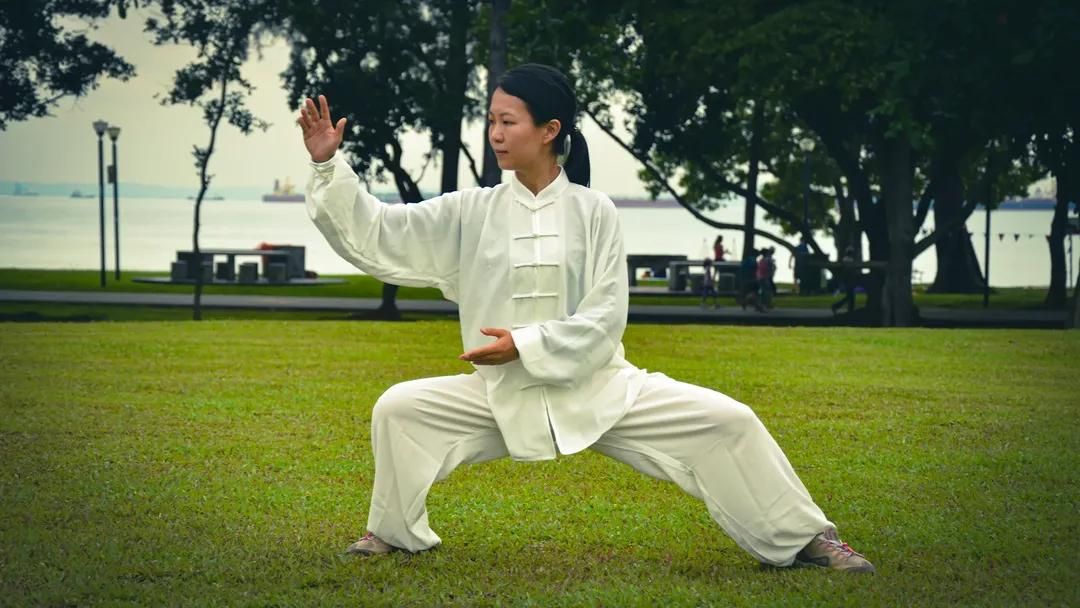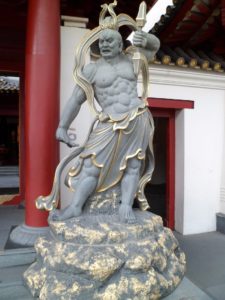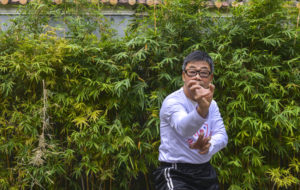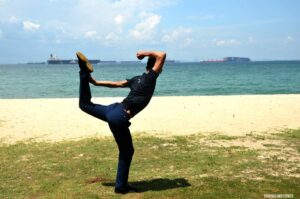The ancestors of Zhaobao Taijiquan left behind a diagram of the Thirteen Postures (十三式). The口诀 (mnemonic verse) states: “The Thirteen Postures of Taijiquan originate from the Dao of Heaven and encompass 64 movements. Each movement must be practiced with thirteen characters: one circle, two polarities, four phenomena, and eight trigrams.
These thirteen characters are summarized as: Circle (圆), Lead (领), Fall (落), Open (开), Close (合), Exit (出), Enter (入), Welcome (迎), Resist (抵), Advance (进), Retreat (退), Rise (上), and Descend (下). Among these:
- Lead is Yang, and Fall is Yin.
- Open is Yang, and Close is Yin.
- Exit is Yang, and Enter is Yin.
- Welcome is Yang, and Resist is Yin.
- Advance is Yang, and Retreat is Yin.
- Rise is Yang, and Descend is Yin.
The practice begins and ends with a circle. These thirteen characters are the guiding principles of Zhaobao Taijiquan’s movements and postures. Where there is Lead, there must be Fall; where there is Open, there must be Close; where there is Exit, there must be Enter; where there is Welcome, there must be Resist; where there is Advance, there must be Retreat; and where there is Rise, there must be Descend.
Stillness gives birth to movement, and movement gives birth to stillness. From stillness comes movement, and from movement comes stillness. Movement is Yang, and stillness is Yin. The transformation between Yin and Yang is endless, giving rise to infinite variations. The practice of Taijiquanis like the Taiji symbol: “When one part moves, the whole body moves,” and “Pulling one hair moves the entire body.” Every part of the body has stillness and movement, Yin and Yang, opening and closing, and emptiness and fullness.
In Zhaobao Taijiquan, the Three Frames (三盘) and Eight Methods (八法) are also governed by Yin and Yang. The Three Frames refer to the upper, middle, and lower frames. Each frame has eight methods, and each method is divided into Yin and Yang. These are summarized as one circle, two polarities, four phenomena, and eight trigrams.
- Upper Frame (上盘) – Hand Techniques:
- The eight methods are: Peng (棚), Lu (捋), Ji (挤), An (按), Cai (采), Lie (捌), Zhou (肘), and Kao (靠).
- These techniques originate from the circle, giving rise to the two polarities (Yin and Yang), which then generate the four phenomena (Taiyin, Taiyang, Shaoyin, Shaoyang) and the eight trigrams (Qian, Dui, Li, Zhen, Xun, Kan, Gen, Kun).
- The hands move according to the eight trigrams, with Lead, Fall, Exit, Enter, Open, Close, Welcome, and Resist transforming between Yin and Yang, emptiness and fullness.
- Middle Frame (中盘) – Body Techniques:
- The eight methods are: Vertical (纵), Horizontal (横), High (高), Low (低), Advance (进), Retreat (退), Reverse (反), and Side (侧).
- In practice, the body moves forward, backward, halfway forward, halfway backward, to the extreme of advancing, to the extreme of retreating, turning sideways, and reversing.
- The body’s transformations, shifts in emptiness and fullness, and adjustments in balance all arise from the changes between Yin and Yang.
- Lower Frame (下盘) – Leg Techniques:
- The eight methods are: Kneel (跪), Lift (挑), Wrap (缠), Flick (撩), Split (劈), Avoid (避), Hook (挂), and Kick (蹬).
- The feet step according to the Five Elements (五行): advancing, retreating, looking left, looking right, and staying centered.
- The East belongs to Wood (Yang), the West belongs to Metal (Yin), the South belongs to Fire (Yang), and the North belongs to Water (Yin). The center belongs to Earth.
- In practice, the upper, middle, and lower frames work together: the hands move according to the eight trigrams, the body moves according to the Taiji principles, and the feet step according to the Five Elements, as fast as lightning, absorbing the essence of the sun and moon and the energy of heaven and earth.
The diagram of origins teaches: “What flows is qi, what governs is principle, and what opposes is number.” This is the guiding philosophy of Zhaobao Taijiquan. The transformations of Yin and Yang are as the ancestors said: “Each of the Thirteen Postures must be practiced with 64 movements, and each movement must be practiced with thirteen characters: one circle, two polarities, four phenomena, and eight trigrams.”
Yin and Yang are the foundation of the human body and the universe. As the ancients said, “The Dao follows Yin and Yang and aligns with numbers.” In Zhaobao Taijiquan, the Yin and Yang of the human body align with the Yin and Yang of heaven and earth. The eight trigrams give rise to endless variations, and one method gives rise to ten thousand methods, beginning and ending with the circle. This fulfills the ancient saying: “Starting from the Dao of Heaven and ending with the Dao of Heaven, achieving the unity of heaven and humanity.”
The movements of Zhaobao Taijiquan are based on the principle of circles: “Using circles to generate circles, using circles to overcome circles, and using circles to transform circles.” The changes in the direction of the circle, the opening and closing of the circle, the emptiness and fullness of the circle, and the interdependence of Yin and Yang give rise to endless transformations. When Yin reaches its extreme, it gives birth to Yang, and when Yang reaches its extreme, it gives birth to Yin. Yin and Yang harmonize, achieving a high level of balance, coordination, and unity.
The Taiji of the human body aligns with the universe. Its movements are light and agile, like “three feet of silk hanging on a shadowless tree,” yet they can be “hard as steel, soft as cotton, slippery as a fish, and sticky as glue.” The transformations of Yin and Yang are unpredictable, leaving one in awe.
1. Yin and Yang in Taijiquan:
- Yin and Yang are the fundamental principles of Taiji, representing opposites that complement and transform into each other (e.g., movement and stillness, opening and closing).
- Every movement in Taijiquan embodies the interplay of Yin and Yang, ensuring balance and harmony.
2. Thirteen Postures (十三式):
- These are the core movements of Zhaobao Taijiquan, each governed by the thirteen characters (e.g., Circle, Lead, Fall, Open, Close).
- The thirteen characters represent the essence of Taijiquan practice, guiding the practitioner’s movements and energy flow.
3. Three Frames (三盘) and Eight Methods (八法):
- The Three Frames divide the body into upper (hands), middle (torso), and lower (legs) sections.
- Each frame has eight methods, which are techniques or principles that govern movement in that frame.
- These methods are rooted in the Five Elements (五行) and Eight Trigrams (八卦), reflecting the connection between Taijiquan and Daoist cosmology.
4. Circular Movements:
- Zhaobao Taijiquan emphasizes circular movements, which symbolize the infinite and interconnected nature of the universe.
- Circles are used to generate power, redirect force, and maintain balance.
5. Unity of Body and Universe:
- The practice of Zhaobao Taijiquan aligns the practitioner’s body with the natural world, achieving harmony between humanity and heaven.
- This is expressed through the integration of Yin and Yang, Five Elements, and Eight Trigrams in movement and energy flow.
6. Practical Application:
- Upper Frame: Hand techniques focus on redirecting and neutralizing an opponent’s force.
- Middle Frame: Body movements emphasize balance, agility, and adaptability.
- Lower Frame: Leg techniques provide stability, power, and mobility.
7. Philosophical Significance:
- Zhaobao Taijiquan is not just a martial art but a way of cultivating the mind, body, and spirit.
- It teaches practitioners to embrace change, seek balance, and harmonize with the natural world.
Conclusion
Zhaobao Taijiquan is a profound martial art that integrates Yin and Yang, Five Elements, and Eight Trigrams into its movements and philosophy. By practicing the Thirteen Postures and Eight Methods, practitioners achieve physical, mental, and spiritual harmony, aligning themselves with the principles of the universe. The emphasis on circular movements and the interplay of Yin and Yang makes Zhaobao Taijiquan a dynamic and deeply philosophical practice.




